#puss in boots analysis
Explore tagged Tumblr posts
Text
Regarding Death Wolf...
Hear me out (NO, it's not the kind you are thinking)
We know Death has a job, right? To collect souls and most likely release them to the afterlife.
And for this job, he has to be there when somebody is about to die, as demostrated with him being there moments before Puss' eight death.
Supposing he is THE Death and he has been doing this since the beginning of time (or at least when there were enough stories of the Grim Reaper to adquire a physical form) that means he has seen a lot, A LOT of awful things.
Murders, suicides, massacres, death of infants, people who didn't deserve to die alone, animal cruelty, some other heavy stuff I won't mention here, etc etc etc.
And we thought "man, how is he able to cope with all of that? That job has to be utter torture for someone."
Probably many of you could think that he is able to do that because he is Death, and he was "born" with that purpose and only him can reap souls perfectly.
But while he is a force of nature, he also WAS a force of nature. Let me explain it well: He adquired a personality enough to be angry, excited, frustrated, amazed, happy, among other emotions.
While he has supernatural power and is most likely the most powerful being in the Shrek Franchise (or in Dreamworks as many say) he is also a PERSON.
Someone with a code of honor, morals, opinions, beliefs, etc.
Returning to the question "How can he bear all of that?" taking into account he is no longer an inevitable force, but a character of his own.
The answer is something you may relate to, and that is: Creativity and escapism.
To be the embodiment of Death, the guy is a very creative fella.
First of all, his design. I heard many people saying here and in Twitter that his design is something they would come up in their edgy, teen years of drawing their first fursona.
Guess what? They are right, the wolf form is someone's fursona. It's DEATH'S fursona. He clearly came up with this badass, piercing canine form to blend with the Fairy Tale Land assuming the form of the "Big Bad Wolf". He most likely had other forms he designed over the centuries and was able to present as them like if he were on a role play game in the living world.
His sickles? The weapon of choice with the little crossed cats on it to have a bigger effect of terror for Puss? Those who can become knuckles and join to create a scythe? Those are his creation, probably after thinking it for a while and writing all of those functions on a paper.
The way he presents himself? In the bar? The coins in his eyes as a "watching you" sign while being a cool reference to the Ferryman of souls? He transforming Perrito's forest into the background of a skull? The chilling reveal at the Cave of Lost Souls? The fire ring? It was all him.
As for the escapism part...
When the world becomes too heavy to deal with as real life issues tend to make us feel bad, depressed, angry... we tend to escape it somewhere. And in our time the common place would be the internet as in webpages or comics, stories, etc.
But what has to do with Death Wolf you may ask?
Well, while he would NEVER be able to escape his job entirely, he can have moments where he can enjoy a good hunt of people who don't appreciate life, like the whole plot of the Puss in Boots sequel could demostrate.
He managed to have a little time outside his eternal routine to chase an arrogant cat who took life for granted. He enjoyed it, it was thrilling, it was exciting.
It was a way to escape a monotonous, grim "life", if just for a short moment.
So, when the chase ended as his prey no longer feared him and now was ready to fight for his last life, the wolf retreats, happy for Puss' character development but resigned because he once again had to return to "The Eternal Duty"
And that's not even counting all the times Jack "I'm dead inside" Horner had to interrupt Lobo's hunt and remind him of his job even in his "spare time"
Death knew the chase had to end eventually, but he didn't want it to end.
He didn't want to return to his own world
And if we look at Death like that, then he is probably one of the most relatable characters Dreamworks has ever make.
In the Shrek Franchise:
Monsters can be loved
Princesses don't have to fit the perfect standards of beauty
Handsome guys can be possesive jerks
Love at first sight doesn't work like one would think
Happily ever afters had to be built and not just obtain them with magic
And Death is the most creative and "full of life" being in the world
Because he would absolutely go crazy with his life/work if he wasn't.
Because in a world of Kings, Poets and Soldiers, he's the Supreme King
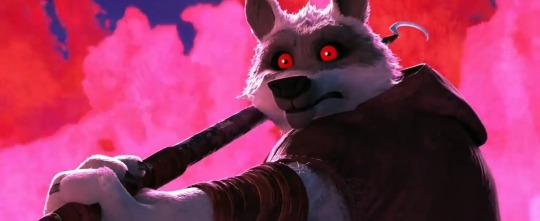
And he's also a perky goth but none of you are ready for that conversation.
#100% sure that if Tumblr was a thing in the Shrekverse...#Death would have an account#puss in boots#puss in boots 2#pib#pib 2#pibtlw#pib the last wish#puss in boots the last wish#the last wish#death wolf#death the wolf#lobo muerte#pib lobo#puss in boots lobo#puss in boots wolf#pib wolf#pib death#puss in boots death#puss in boots analysis#character analysis#escapism#creativity#shrek#dreamworks shrek#dreamworks#this is probably the discovery of the decade#or the stupidest thing I ever wrote on this website
3K notes
·
View notes
Text
Thing I just realized after talking with one of my friends on discord, I believe that, since puss had been on his own for most of his life, there’s a very strong possibility that he could be really fricking touched starved. But because of what happened with humpty, with the egg not only tricking him once, leaving him no choice but to become an outlaw, leaving his poor mother at the orphanage. And I can’t imagine the pain he felt upon seeing the heartbroken look in his mothers eyes. That’s something that stays with you for life. but twice when he was tricked into helping steal the golden gooses duckling by someone he once called a friend and brother. Inevitably leaving him to say good bye to humpty for the last time- would understandably cause him to have trust issues, and thus would make it really hard for him to form other connections.
Which brings me to my next point: leaving kitty soft paws at the altar.
It was mentioned in the last wish that puss, for once in his life, felt scared, and thus could not go through with it. cause, when you’ve been tricked by one of your closest loved one and only friend like he was, the thought of connection would be terrifying for him. Now what he did was still wrong, but it paints a really heartbreaking picture all the same. I’m sure a big part of him really wanted to be at that alter, cause he really loved kitty soft paws, that’s something I’m certain of, and so did she. But even with that fact he was still too scared to be there. And that’s something he’s admitted he regrets deeply.
Another thing I want to point out is the scene in the cat lady’s house in the last wish. When puss was forced to act like a normal cat, like eat cat food, use the litter box. And worst of all (in his opinion) being surrounded by cats in a cuddle pile in the evening and night. Now what makes this scene worse for puss is the fact that, since he has trust issues, it would make sense that he wouldn’t let just anyone touch him. So while being touch starved, he could also be touch aversive, just look at his body language in these shots:
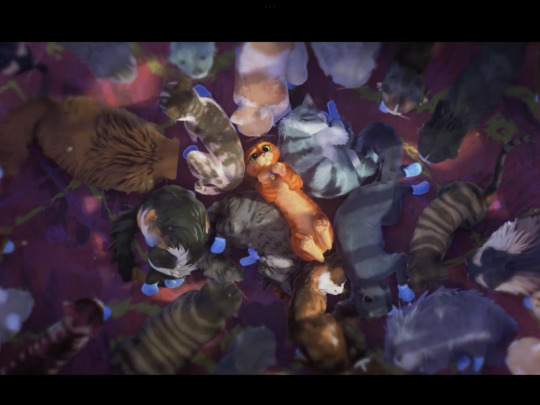
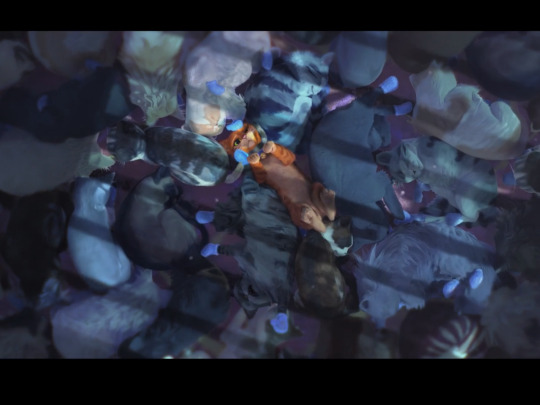
His whole body is all tensed up, and he has his front paws under his chin, trying to keep from touching anyone. But by the second one, he seems like he’s given up entirely. though he still has his front paws in the same place. I’ve never seen someone look so lonely surrounded by strangers, cause that’s what they were: strangers. He never once relaxed. Thank goodness purrito and Goldie appeared when they did, cause I don’t think he could’ve lasted any longer in that place.
I’m sure he was so relieved to leave there, and reuniting with kitty was an added bonus for sure, even if they weren’t on the best of terms for obvious reasons.
#puss in boots#puss in boots the last wish#puss in boots the last wish spoilers#puss#humpty (dreamworks)#kitty softpaws#purrito#puss in boots analysis#my poor baby boy#you’ve been though SO much#also humpty can go fuck himself
78 notes
·
View notes
Note
Tell me every reason you enjoy Zootopia enough to give it all the rewatches you do.
Every? Oh boy.
Good Story
Perfect Characters
Visual Appeal
Earnestness
Let me break it down.
1. Good Story
Zootopia’s main point is: “Try to make the world a better place by realizing we’re fundamentally the same.”
That’s a really good main point.
It has the benefit of being true. Right now our culture is super into “self-identification,” and this crazy contrast between, “I want to be able to identify as something special” and “Now that I know what categories I fit in, I can choose who’s ‘one of us’ and who’s ’not one of us.’” Okay well that sounds pretty and I’m sure it fulfills some emotional need at some point, but it’s actually super divisive, and self-serving, and it’s the seeds for all prejudices. Including racism.
Do we have differences in origins and experiences? Yes. Of course. Do we also have some fundamental things in common? Yes. Of course. Which truth are you going to give the highest priority to? If it’s “no, I’m a prey animal, I know exactly where I belong, that’s who I am, that’s how I dress, that’s my compass for how I interact with others” then you’re getting all your security from your “sense of self,” and being able to understand what that is…which is just a fancy way of saying “I’m all about me. My own perspective informs everything I do.”
Anyway. Zootopia’s message was super true.
And the coolest thing about it is that if only Judy were in the wrong, and the other half of the dynamic duo, Nick, was this open-minded, un-prejudiced guy…and she just hurts him and has to apologize…the movie’s message wouldn’t be as well-communicated.
They have their prejudices and their hurt-from-being-prejudiced-against in common!
They’re the same…because they’ve both felt what it’s like to be treated like they’re not “the same.”
Nick isn’t the only character being mistreated and written off because of his species. The whole first half of the movie is about Judy being mistreated and written off. They think she can’t be a cop because she’s little and cute and a prey-animal. They think Nick can’t be trustworthy because he’s sneaky and small and a predator.
So literally…if Judy represented one race, and Nick represented a completely different race…the movie would be saying that both those races are discriminated against. They even have discrimination in common. AND, if Nick represented men who people make assumptions about because he’s a man, and Judy represented women who people make assumptions about because she’s a woman—the movie would be saying that both those genders are falsely judged.
I mean. Wow. Right now, your movie is either pro-woman or pro-man. Right now, your movie is either BLM or white-supremacy. Everybody’s lining up on one side of the line or the other. Zootopia says, “it doesn’t matter what character you’re looking at, from the elephant that can’t remember anything to the two main characters—every single one of them has fundamental things in common, and one of those things is that they all live like they’re in their own special category. When actually, they’re all fundamentally the same.”
I don’t want to keep beating the dead horse. But I have a post somewhere that lists every background character and points out that each animal is the exact opposite of what you would assume they are based on their animal-stereotype. The otters are never shown being playful or snuggly, only traumatized and ferocious. The cheetah is fat and slow, not quick or even quick on the uptake. Etc.
Even if you look outside of characters—look at the sets. Look at the environments. The whole city is designed “for animals, by animals.” But it’s in neat little segments. The animals organize themselves by habitat. Of course, in one sense that’s practical—the polar bears can’t live in Sahara Square, etc. but the point is, by making Judy and Nick, the main characters, small animals, in a city where everything is built to accommodate by species—UGH this is so good—they have to figure out how to problem-solve in situations that weren’t made to accommodate them.

Little Rodentia? Judy has to avoid stepping on all the mice or knocking over their buildings. Parking tickets? She has to figure out how to jump to reach bigger animals’ windshields—or she inconveniences smaller animals because the tickets are all printed at the exact same size. Stuck in a cell? The guards didn’t think about the fact that small animals can fit down the pipes made to accommodate big animals.

Zootopia is a city advertised to be where all the animals can come together. But the way they do that is by trying to accommodate every species’ preferences. So then actually while they try to come together, everything from their cars to their districts remind them of their differences. The whole idea is that they prioritize the wrong truths. Yeah, mice can’t drive giraffe cars—but they still have “driving” in common. See?
And oh my word. Initially it was supposed to be a spy story. But they changed it to a buddy cop story. Why? Well because justice doesn’t discriminate. Or at least, it’s not supposed to. So then there’s another lens to look at the story’s main theme through.
It’s just that every layer, every perspective you look at the movie from, is just hammering that truth into you: “Try to make the world a better place by realizing we’re fundamentally the same.”
2. Perfect Characters
Every character is so well-thought-through in this movie, even the side characters. You get the feeling you could watch a whole movie based on the side characters, because that’s the amount of love and nuance built into them.
Look at the main ones, though. Bellwhether is supposed to be soft and a follower. She’s a sheep. Instead, she’s hard and bitter—and she’s a leader. A villainous leader, but a leader, nonetheless. Even as she tries to keep animals divided based on fear of their stereotypes, she’s not fitting her own stereotype. Her voice actress has this strained, half-hoarse, but sweet voice. Like you can tell that this character has spent a lot of time under pressure and trying to manage appearances. Appearing like she’s fine, and she can handle it—until you realize that the appearance she’s really managing is “the cultural fear-based identify of the city.” They dress her in plaid and flowers and she’s a farm animal, because that’s the kind of character Judy would be most likely to trust. But she still has green eyes, and jagged teeth, so that when she does start making evil expressions there are some caricature-pieces in there that come out and accentuate that.

Nick Wilde—everybody’s favorite—is supposed to be sly and smooth and shifty. And he is. He’s a fox. But he’s also brave, helpful, and trustworthy. The first time you see him is when he’s dodging out of the way of a bigger animal ignoring him and about to run him over. Well, that’s important.

Because Judy knows what it’s like to have to get out of the way of larger animals, because they overlook her.

So right off the bat, this character she has to get along with and work with, this character who furthers her development and nails the main point, is introduced in a way that has something in common with her. But he’s also introduced in a way that gives her an opportunity to focus on a different truth—that he is different from her. Because the sheep is yelling that he’s a “fox.” Right away, we’re back to species-as-identification.
And that’s what the movie does, all the way through. It presents new animal characters, and with those new animals characters, more than one thing is true at a time. And Judy has to try to focus on which truth is more important. “Try to make the world a better place by realizing we’re all the same.” Yes, Nick is a criminal. But Nick is also brave, helpful, and eventually, becomes trustworthy.
Judy, too. Judy is an incredibly well-done character. Because she believes, in her head, that anyone can be anything—which is not what the movie ends on. In fact, she goes from saying, “anyone can be anything,” to saying, “we all have limitations.” It’s not true that a fox can be an elephant. But it is true that a fox can be trustworthy. Figure out what’s true, and try to make decisions for the better, based on that.
I could talk about character design and acting. Ginnifer Goodwin gives just the right amount of smugness and self-confidence to Judy without making her unlikeable—you don’t realize she’s smug and her self-confidence is misplaced until she does, when she fails to make the world a better place for Nick.
Judy wears tight, actionable, well-fitting uniforms for the whole movie. In her civilian clothes when she comes to Zootopia, she’s wearing athletic t-shirts and shorts. Ready for action, that’s Judy, even in her civvies. Meanwhile, Nick? Nick wears loose-fitting clothes. Loud, patterned clothes that don’t match. Like he didn’t even what, ladies and gentlemen? Like he didn’t even TRY. “Try to make the world a better place…”
Because when you meet Nick Wilde, he’s long since given up on trying, in life. So his character design reflects that. He rarely even stands up straight, or opens his eyes all the way—his default is drooping. And guess what?

When Judy “gives up?” Quits her job? Goes back home? Stops trying? Her civvies aren’t ready-for-action, trying clothes. They’re loose flannels. And her “ears are droopy.”
SERIOUSLY, you can find things like this in every corner of the movie. For every character. Not one character is a throwaway, not in voice acting, not in design, not in animation, and not in narrative.
3. Visual Appeal
Which leads me into this point—no other animated anthropomorphic animal movie is as visually appealing as Zootopia.
What Zootopia does is it matches the best of the best anthropomorphic animal designs from past Disney movies:
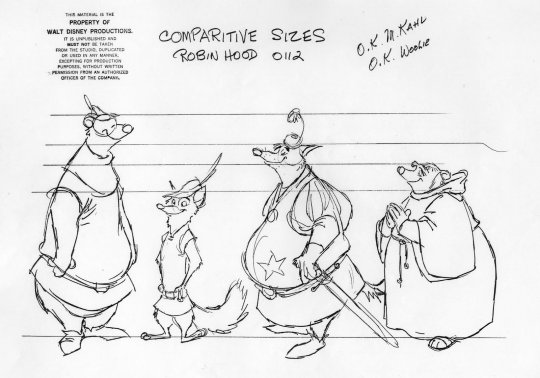
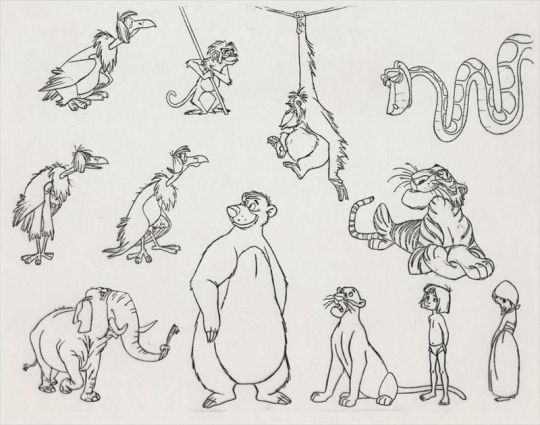
And they marry it with this incredible intentionality with modern CGI.
Did you know Disney invents its own software for things like fur textures?
The sheep’s wool, the velvet pig skin, the fox fur, the bunny fluff—it’s all completely different textures. There’s no one “fur” covering all the hairy mammals.
Nick isn’t just orange. He’s orange with deep red and dark tufts. Judy has black tips to her ears, too—which helps the two of them look like, in some sense, they belong “together” in every shot.

It’s so important to the movie that the animals feel like animals that they worked this hard to do this. And then that extends to the textures of the snow, the ice, the sand, the wet leaves, the grass, the fire.
Every character moves like their animal, and like themselves. Nick and Gideon are both foxes, but they don’t move similarly at all. Gideon is aggressive and glowering and physical. Nick, again, is slouchy, leans on everything, completely non-confrontational.
Other anthropomorphic animal movies like Sing or Puss in Boots—they’re not doing both as well. Zootopia is appealing, without sacrificing realism completely, and without cutting character acting.
The lighting. Nope. This post is too long, I can’t talk any more.
4. Earnestness
There is no disingenuous moment in this movie.
The animators are never lazy. They always go for the challenge. They don’t cut corners. Have you ever seen “Over the Hedge?” I like Over the Hedge. But I watched it recently and it’s crazy how many shots are strategically placed so that the animators don’t have to solve a certain effects problem.
For example, when RJ sprays Hammy with cool whip to make it look like he has rabies? He doesn’t. You never see the cool whip leave the can. It just cuts away, then cuts back when RJ is pulling the can away from his face. The shots are also cut so that you never have to see gas actually come out of Stella—and you never see Vern’s full body as he gets back into his shell, just the upper part of the shell as he wiggles it around, going through the motions of putting it back on.

That’s because that stuff would be painstaking to animate. Any time one character has to interact with props or substances (especially liquids) that are not part of their model, it’s harder on the animator.
Zootopia? We’re getting full-on views of characters getting wet, fur and all, characters touching various objects and elements, foam coming out of the mouth, new clothes, new set pieces, multiple models, huge crowd shots of different animals in different outfits, all with their own movement patterns and acting.


And all that hard work and effort, aimed so totally at the main theme of the movie? Making sure it looks as good as it can? Not just that, but the way it’s written, the acting, is so genuine. They don’t hold anything back. They don’t shy away from real emotion.
Judy Hopps’ apology scene is brutal. She’s crying, having a hard time finishing a sentence, her voice is all tight. It’s not pretty, it’s not romantic, it’s like…ugly crying. And her character is wrong in a super embarrassing way. They're not afraid to go there. The writers, the actors, the animators—they’re not afraid of being too vulnerable with these character flaws.
So many movies, especially kids’ movies today—they just pull up and shy away from being real through their characters. They think a quick sad facial expression will get the point across. And it does. The audience gets that the character feels sad about whatever the circumstance of the scene is. But not as powerfully. Because you didn’t put as much work and heart into it.
Zootopia is all heart, from work ethic to vulnerability to the filmmakers enjoying what they’re doing, enough to make it as good as it can possibly be. I can’t explain it better, other than to say, you feel like they would’ve been happy making this movie much much longer than it was. You feel like they’re cramming every bit of joy and passsion into every little joke, every side character, every hair on a CGI bear.
There you go. Long post, you did ask for it
#Zootopia#Nick Wilde#Judy Hopps#Zootopia appreciation#anthropomorphic animals#Fox#bunny#Disney#Zootopia 2#Jason Bateman#ginnifer goodwin#byron howard#meta#character analysis#design#over the hedge#puss in boots#sing#movie#animation#character design#character study#critique#review
218 notes
·
View notes
Text
We all know this scene when Puss faces his past lives.

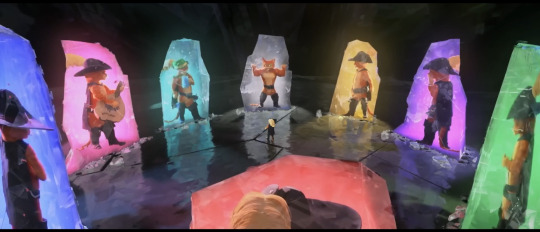
Spoilers
I'll be honest, something was disturbing in this scene when I first saw it. I'm rewatching the scene and trying to put my finger on it. Then it hit me. That Tik Tok comment I saw that said the Lost Souls were acting like the sins from the Bible. The connections people made from this film and toxic masculinity. This scene right here is oozing with toxicity and masculinity.
Before I go any further, I would like to say that I am not down-talking men. I'm analyzing this scene as a Mexican woman.
Anyways, here are some traits in toxic masculinity.
Self-reliance - Men believe they have to do all the work and handle everything by themselves. Independent at all times, they need no one. They believe doing things by themselves will make them successful in life. Being vulnerable will cause the man to be ridiculed. That's Puss throughout the film.
Promiscuous - There's nothing wrong with having sexual relations with others. If it's your thing, it's your thing. But there is such thing as too much of a good thing. Being flirtatious is ok, healthy even, but when it becomes very frequent or an obsession, it can lead to problems in forming long-term romantic relationships. Puss in a nut shell.
Being violent and dominant - Most men believe they have to be strong, physically mostly. So they take risks in life and try to beat others in their own game. Taking risks can be a way to demonstrate dominance. This can include gambling as well. Or dangerous sports. The cause of some of Puss deaths. Not to mention Death pretty much gave Puss a reality check. Puss isn't as strong as he thought he was.
And a big one, refusing to seek help when struggling - self-explanatory. Men try to be emotionless and never seek intimacy with others. Especially with other men as it's seen as a weakness.
All these traits are displayed in this scene. At first, it's fun for Puss because he remembers how much fun he had in his past lives. All the parties, lovers, drinks/food, adventures, risk-taking, everything. But once the adrenaline wears down, Puss knows it's time to leave. But of course, the Lost Souls don't let him. They try their best to convince him to leave Perrito and Kitty and get his lives back. They straight up tell him he doesn't need them and he's better alone. But at this point, Puss already formed a bond with Perrito and is reconnecting with Kitty. He remembers his regrets and this is what makes him determined to go back.
I guess the Souls notice this and start to ridicule Puss for being so vulnerable. Which is something I pointed out already in self-reliance. Men get teased and made fun of if they show even an ounce of vulnerability. Men can't have intimacy with their friends, let alone friends who are men. Men can't be held down by marriage. It sounds over the top but it does happen. I've seen it happen in the past in my household.
Men are also pushed to be physically and emotionally strong. Which is what Puss was trying to do as well. He didn't want to be afraid. He didn't want help and was a lone wolf. He refused to seek help when struggling. Thankfully for him, Perrito was a very determined guy. He followed Puss and helped him become more vulnerable and to open up more. Fixing his relationship with Kitty and becoming fiends.
So yeah, this scene was something alright. Puss was already developing at this point of the film. And then they made him face just how toxic he was being in his past lives. It almost felt like torture for him. But this is an important step in developing into someone better. You have to face your past some time and realize your mistakes so you don't make them again.
Ps, Antonio's voice acting here was incredible. Voicing nine different Puss while making each one unique. From the tone of voice to personality. He deserves some recognition for this scene.
#puss in boots: the last wish#puss in boots#just had to get this one off my chest#because this film#was something special#movie analysis
2K notes
·
View notes
Text
Spoilers for Puss in Boots: Last Wish (specifically Perrito) below
My bff and I were talking about this last night, but I figured I’d write it all out here: one thing I really do appreciate about Perrito is that while other characters may see him as naive and innocent, the film never treats him as overly naive or foolish.
The best example of this is when he’s explaining his backstory. It would have been SO easy to have him be still searching for his family/litter mates, believing firmly that they still wanted him/were still playing ‘hide and seek’. If they’d done this, then Perrito really would have been an extremely naive character (as well as all the more unnecessarily tragic). It also would have been easy to have this be Perrito’s wish, as well as the lesson that he needed to learn - that he doesn’t need his former (and incredibly crappy) fam, and that he can/should move on from his tragic backstory, letting himself be with his new friends instead.
But the film doesn’t go this route... Because Perrito has already realized and internalized this lesson.
Think about it. For as much as he may seemingly still see the whole ‘swim in the river’ incident as an extra challenge to a game of Hide ‘n Seek, outside of the “Guess I’m still It!” joke, Perrito doesn’t dwell on the fact that he never saw his family again. Just as he never dwells on nearly drowning. He only brings up his past when others ask him about it, otherwise he’s only focus on the present - which is why he’s so satisfied with things to the point of not needing a wish.
When it comes to his backstory, he instead just sees the brighter side of things regarding it (getting a new ‘sweater’ that he was able to grow into) and focuses on moving forward and meeting new friends, instead of going on an endless search for those who left him behind. Even while he’s at Mama Luna’s, he still tries to socialize with the other cats - though he backs off when they hiss at them, still understanding that he isn’t exactly well-liked there.
What’s more, it’s made VERY clear that Perrito’s tendency to trust in people without hesitation is not out of naivete: it is out of choice. He knows that people can be cruel (we see him briefly get scared of Jack Horner and the Bears when he gets kidnapped, even if he ends up making friends with the latter) and he knows that he can’t exactly fight back against that, being such a tiny dog. But he’d still rather give people a chance instead of just hiding away from the world. He never tries to claim that every person has some good in them or anything like that, he simply states “well, you have to trust somebody”.
What really drives this point home - aside from the excellent advice that Perrito gives throughout the film, showing just how thoughtful and wise he is, even when he seems totally clueless in other moments - is his moment in the film’s climax with Jack, where he’s finally able to do the cutesy eyes. The joke is how Jack is ‘dead inside’ and would never fall for such a ploy, and how Perrito is (or rather, would be) dumb for thinking that simply being cute would stop this heartless bastard.
But the twist is that Perrito already knows this. There isn’t a moment where it’s shown that he thinks this act will work. No, Perrito meant it as a distraction the entire time - he wanted to try and help, and he trusted his friends to catch on and take the shot once the distraction worked. And I freaking LOVE THAT! I love that Perrito is so much more than just ‘diet Donkey’ or ‘innocent and naive dog that doesn’t know how the real world works’.
He knows how it works, he just chooses to still see the bright side in things in order to improve others’ lives as well as his own, because there’s a difference between naively trusting people who haven’t proven themselves and just giving people a genuine chance to be your ally/friend. And I’m just so happy that Dreamworks not only made a character like this but just did a fantastic job writing him.
#puss in boots the last wish#puss in boots#perrito puss in boots#sorry I just had to take some time and gush about one of my fave characters from this movie#(the other being Death. of course)#character analysis
1K notes
·
View notes
Text
something about the way Kitty can't help but end up trusting and loving others despite all the ways she has been hurt, and her own insistence that she does not trust others. The way that she so naturally falls into trusting Puss when he shows a modicum of honesty and genuine emotion to her.
I think Kitty is someone who has a lot of love in her heart, a fact she hates about herself because it leads to her getting burned quite often. She feels like she cannot ever truly practice what she preaches and just stay away from caring. Even, towards the end, she gives up her wish to Puss, not because she thinks he deserves it more, but because at that point, even wishing for someone to trust feels like a failure on the part of herself to just learn her damn lesson and stay away.
Which is why it is so important that she finally gets what she needs through Puss. That she witnesses him fighting for his life instead of running, fighting for his right to love her for the short time on this earth that he has left. She needed to hear this from somebody, that she is worth caring about. More than just a cute pet that looses its luster when it starts scratching the furniture, more than just a fleeting fancy abandoned the moment something goes wrong. She finally has someone tell her she is worth recieving the love and trust she so easily gives, in equal measure.
#puss in boots the last wish#kitty softpaws#i couldn't fit this into the post without it being awkward but the scene with her and perrito#she is shrouded in shadow when she is telling him to trust noone#which is the way the movie signals that a character is lying or omitting something#(see: earlier scenes where goldie is shrouded in shadow when she refuses to tell her wish)#Pussy Analysis
535 notes
·
View notes
Photo

This thought just suddenly came to me - “Big” Jack Horner from Puss in Boots: The Last Wish is essentially the Chloe Bourgeois that Thomas Astruc intended to write in Miraculous Ladybug from the get-go and has since desperately been writing even when his prior failure contradicted it: a spoiled, privileged, entitled, petty, sadistic, and humorously self-aware and over-the-top sociopath who loves no-one but themselves and can never ever be redeemed.
This was the intended audience reaction to Chloe:
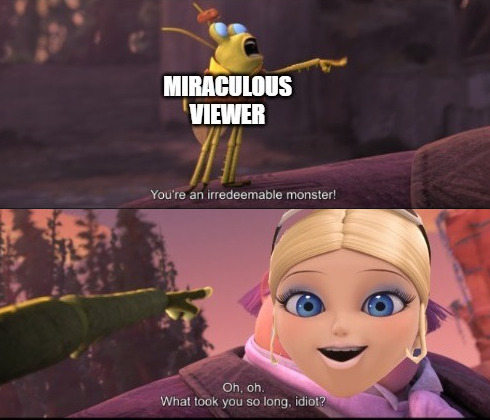
Unfortunately for Astruc, for some reason or other he bungled this completely in Seasons 1-3 of the show, portraying a Chloe that had significantly more nuance than that, which means now he’s stuck jamming a square peg into a round hole and insisting viewers go along with it.
#Miraculous Ladybug#Dreamworks#Puss in Boots#The Last Wish#Chloe Bourgeois#Jack Horner#Evil#Villains#Opinion#Analysis#Comparison#Anti-Miraculous Ladybug#Anti-Thomas Astruc
582 notes
·
View notes
Text
Spoilers ahead for Puss in Boots: The Last Wish
I can’t stop thinking about The Last Wish (go see it if you haven’t, seriously, it’s incredible) and I wanted to talk about a moment that I think carries a lot of meaning even though it’s easy to gloss over.

I want to talk about the moments before and after Puss draws his gatito blade against El Lobo del Muerte.

During Puss’s climactic duel with Death, the Wolf slashes Puss’s boot, bats away his hat, and knocks his sword out of his hand. The Wolf is destroying the symbols of the legend of Puss in Boots, stripping Puss’s mortality bare.
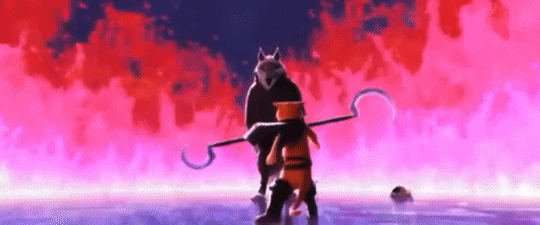
But Puss is no longer defenseless before Death. He has spent the movie’s runtime building bonds with other characters, finally letting others into his life, no longer walking alone as his legend demanded. His gatito blade, given to him by Kitty Softpaws, represents this development. Puss has cast aside his legend through learning the value of his life, and in doing so, he can stand against and block Death’s blows.


Ironically, Death’s attempts to take Puss early are the very catalyst for Puss’s success in redefining himself, symbolized by Death’s blocked blow allowing Puss to reclaim his symbols—his hat and sword—with their meaning now changed by the accompaniment of the gatito blade. The unstoppable weight of Death’s scythe has quite literally pushed Puss towards a new life.
The Last Wish is packed with moments of visual symbolism, but this one in particular is the standout to me, both because and in spite of its brevity.
#the wording in this feels awkward but whatever#media analysis#visual themes#themes#symbolism#gatito#el lobo#big bad wolf#puss in boots#pib#the last wish#puss in boots the last wish#pib the last wish#puss in boots the wolf#kitty softpaws#film analysis#analysis#mortality#the last wish spoilers#🐍
600 notes
·
View notes
Text
I hope we continue this trend of having a breakout animated film at the end of every year from now on.
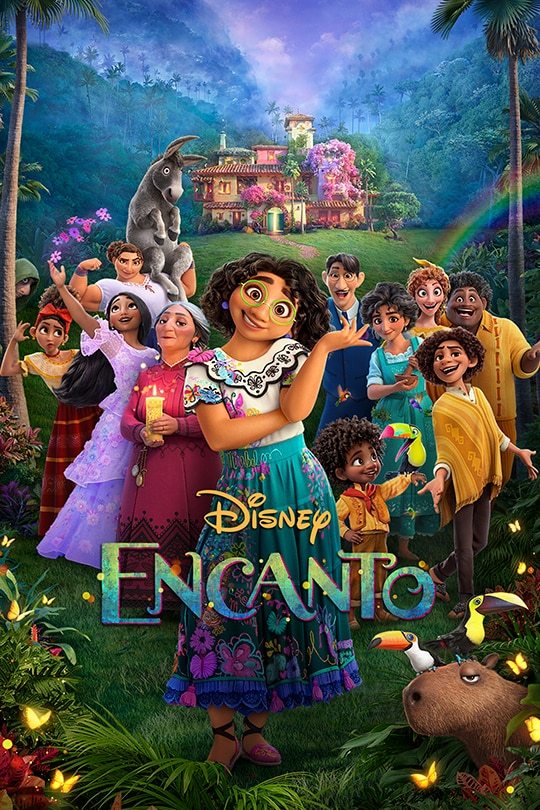

#for 2021 it was encanto#for 2022 it was puss in boots#both have latino protagonists too#and both have spawned fandoms with a lot of creative artwork memes and analysis#it's delightful and i hope this continues#encanto#puss in boots#puss in boots the last wish#animation#disney#dreamworks
635 notes
·
View notes
Text
ok soo i was trying to figure out how pib's character fit into the thematic web of the neverafter and it made me think of like. pib & aesop acting as foils wrt to the concept of morality in fairytales
i think pib, in a very roguish way, represents moral neutrality/amorality. he will lie, cheat, steal and kill happily and unrepentantly (because lying is SOO much fun) - but he also does it without any real sense of malice or greed. like its important that the core of the original puss in boots story was him lying in order to help tomas. pibs lies are never centred around hurting anyone, but rather to help himself and his friends.
conversely, i think pib also recognises the need to do traditionally "bad things" to survive. like he WILL absolutely give the mule the shit for betraying them, but ultimately also understands that it was what was necessary for him to survive. and he cant fault him for seeking safety and refuge. which is why i think pib could represent a kind of amorality (or at least morals in the fairytale sense). like literally adhering to a universal moral code is simply unimportant to him. not a factor of consideration. he is protecting himself and his friends, and thats what matters (and of course what else should matter to a tricker cat)
this is in contrast to aesop who is like, from his introduction, defined by his strong sense of morality. he is also fundamentally a good person, but he believes that that goodness is manifested through behaviour that adheres to a moral code. his stories are strictly cause and effect. you act good, you are rewarded / you act bad, you are punished. also, beyond that, i also get the sense he thinks his stories are superior for having that stricter morality? (hopefully i didnt misremember this bit, but) he says that the neverafter is more susceptible to corruption BECAUSE of its lack of moral clarity & rigidity. but it seems that he believes the world SHOULD operate within that strict moral system (aka he is a TOTAL SNITCH!!). thus, in contrast to pib's amorality, aesop represents a hypermorality - adherence to a universal moral code that allows for no exceptions no matter what.
- also, side note, from this framework it might also explain why pib & pinocchio team up at the beginning. like pinocchio IS in the transitory stage from the aesop-like fixed moral to the kinder neutrality of "lying cant be bad if it saved my father" -
anyways! idk if this is something that will ever come up or was intended. PROBABLY not! but its an interesting parallel i think!!! ummm neverafter fr makes my brain go brrrrr
#ummmm i hope u like my analysis !#dimension 20#neverafter#d20#pib#pib neverafter#puss in boots#puss in boots neverafter#aesop neverafter#dimension 20 spoilers#neverafter spoilers#ramble tag
485 notes
·
View notes
Text
Two fun things about Puss in Boots you can catch on a rewatch:
Y'all ready for me to blow your minds? You could always see Puss's lives carved into Death's left scythe, even in the first fight of the movie.

Here you can see it on the inner groove. It's hard to get good visuals throughout the movie but if you're eagle-eyed you can catch it at least 5 times before the big reveal.

Here it is again when Death almost kills Puss the first time. It's so subtle but once you see it, it makes the rage in Death's eyes make so much more sense, it makes his motive so slap-in-the-face obvious I didn't know how I didn't notice it the first time I watched this movie.
There are at least 3 more times you can see the carvings before he draws attention to them that I found. The first time is when Death breaks into the bathroom and Puss escapes, and the second is the scene before Puss's anxiety attack in the woods, where Death brandishes his scythes - you can see it in the smear frame before he wields them. The final time is the most obvious, before Death smashes the second crystal in the Cave of Souls:

Also I love that Puss has a lisp only when he says gazpacho I just think that's a funny bit of characterization
The attention to detail in Death's design is remarkable. Some movies wouldn't have even tried adding the lives on the scythe until the reveal was convenient, but having them be there the whole time with Puss unaware really adds to the tension and the shock of realization that Puss has been stalked by Death for his whole last life. It's so fucking cool. Also Puss's recollections of Santa Coloma differing when he tells Perrito vs when he's in the Cave of Souls is so good:

When he tells Perrito it's overcast but the lighting is more warm and colorful, it shows a bright future ahead for Puss if he could overcome his fear and enter the church.

But when Puss really stops and thinks about the moment, the truth is revealed. It's unsaturated, it's desolate, it's lonely for Puss in the moment. The future he wants with Kitty feels so far away it's almost unreachable, too far for him to overcome his fear.
God I fucking love this movie. It's so incredible and has such immense rewatchability.
#puss in boots last wish#puss in boots 2#puss in boots#movie thoughts#film analysis#cinema#dreamworks#i fucking love cats
459 notes
·
View notes
Text
I think Kitty was telling the truth when she said she never showed up to the wedding. And I have a couple of reasons why: (warning, its long)

1.) Her entire character arc is learning to trust. This includes opening up and being honest about herself and in this case: her past. So it makes no sense for the story if she just LIES about Santa Coloma, especially after making a big deal over it. If anything it would take away from the scene and her character when she finally open up.

2.) I think the only way they could have saved the relationship between Puss and Kitty naturally, after Puss left her at the altar. I kept thinking "how can they possibly save this relationship after what he did" and the answer the movie came up with was HILARIOUS! Her not showing up was the perfect answer to that conundrum.
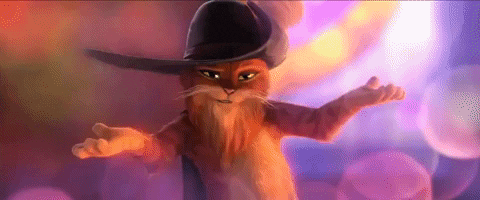
3.) I think she was more mad she was proven right, than she was about him leaving her. That he did pick himself and his reputation over her. And he was so full of himself that he never checked on her after leaving. And she knows he didn't check up on her based on his reaction and the fact he never brought up her leaving. She's not like Puss, she knows about his adventures and what he's been up to. Thanks to his status as a legend, she knows about ALL of his adventures. But he doesn't know about hers, and didn't bother to find and confront her. That's how she knows he didn't know her side.

4.) Her being mad at him, was because she thinks he betrayed her intentionally and maliciously. She may know that he didn't show up, and based on his reaction, does not know about her doing the same. But it's not until his breakdown, where she listens to Perrito and him talk, that she finally understands WHY he did it. And how much it hurt him to do so. That he is legit ashamed of himself. Before that moment, she was sure he was out to betray her, like everyone in her life. But after she hears the real reason, she stops treating him so harshly. She opens the dialogue/ gave Puss the opportunity to talk about it with her. You can bet that she was the one that got them so high in the trees. After all she has no claws to climb, and yet she was so far in front of him, as if leading him up to a place he would have naturally been given him an advantage... But she's trusting him. Its Kitty who opens up the conversation with the "if you wanted to hold my hand/ I remember the last time you did this you had cold feet " dialogue. And when he takes her up on it, and nervously tells her what/ why he did it, and how it is EXACTLY like he told Perrito, she rewards him by finally coming clean about what she did. Why she left him too. And finally tells him the whole truth on the matter.

You can also tell that that's the moment she truly starts to fall in love with him again. "You don't seem like that guy anymore." Is a statement that has so many layers to it, but the biggest implication is that this version of Puss, is the one she is starting to trust.

The shaving scene may have set the mood earlier on the movie, but this open and honest conversation, is what made her swoon and start to believe in him.
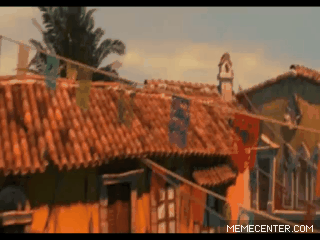
5.)I think it sets up a good story/ contrast to who they were at the beginning, and who they are now. And by beginning, I mean them at the end of Puss and Boots 1. In that movie they're flirting, equals, in love... but their relationship is also unstable. She ended that film stealing from him and running off. And in the Shrek franchise, its shown Puss is quite the flirt with the ladies, imlplying they're not together. This Santa Colona flashback fills in the blanks for what happened between the movies, and also shows that when they first met, they may have been too young for each other. Too inexperienced. Not old enough to want to actually settle down, on both ends! If I were to hazard a guess, I'd bet that Puss proposed spontaneously, and she accepted in a moment of excitement, but leading up to the ceremony they both got more and more nervous until eventually, they both got cold feet and dipped, but for different reasons. He was too obsessed with himself and worried about his legend, and she was too flighty and could not trust him. Which ended their relationship (this is mostly HC though. Just speculation on my end.) But now they're both a lot older. They've lived a few lives, though we don't have a concrete number, there's clearly been many years between now and Shrek 4. And Puss in Boots 1 was a prequel to the Shrek series so, yeah, they are both MUCH older now and are both finally at a point where the two are ready to settle down and be together.
Who they are right now, is the best version of themselves. And in contrast to the last moment, instead of her running off with his boots, they are sailing away together, with him in her arms.
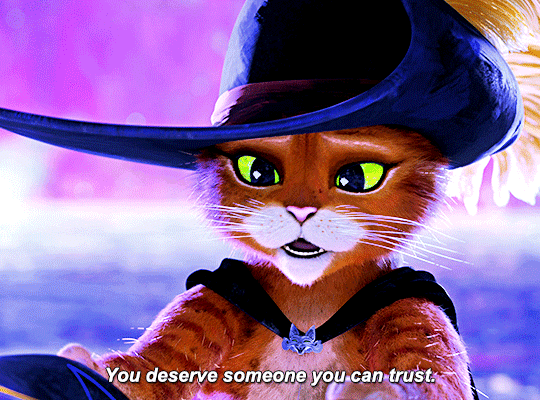
I understand the appeal of saying she lied... but I LOVE the implications of what it means for her to be truthful.

They are currently my FAVORITE couple is Shrek franchise. Softboots is perfect! And it's their open honesty and trust in one another, that makes it so.❤
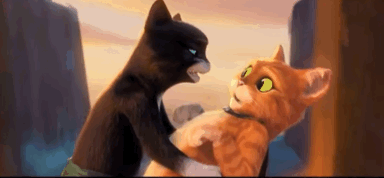
#kitty softpaws#puss in boots the last wish#puss in boots#puss in boots 2#Perrito#analysis#softboots#santa coloma#spoilers
195 notes
·
View notes
Text
My favorite scene from puss in boots the last wish.
tw: visual of panic attack
THIS SCENE MAN! QvQ
I’ve never experienced a panic attack before (thank god) but this scene really captures what it’s like to have one, even if you yourself haven’t had one. And to people that have, they might see themselves in this scene. The fact that puss looks so helpless in this scene really tugs at your heartstrings, cause until this point, we’ve never seen him like this. he’s always been this fearless adventurer that laughs in the face of danger, and LOVES the sense of adrenaline he gets from being in dangerous situations. Cause despite being in danger, he’s always in control, and has the means to escape deaths grasp.
But it seems this time, death himself is hunting him down, and for once in his life, he is TERRIFIED. and he doesn’t know what to do, cause he’s never been scared like this. So having a panic attack when you haven’t had one before must’ve been really scary for puss, cause he doesn’t understand what’s happening. He’s shaking all over, he can’t focus, and he can’t breathe. When he’s scared like this he loses any sense of control he has, leaving him a vulnerable mess that would be easy pray for anyone nearby. And that is the most terrifying thing of all, cause in this state he wouldn’t have the means to defend himself cause his mind is constantly telling him to run and hide from danger, even if there’s nothing around.
Purrito was the MVP in this scene, you can tell that he had no clue what to do, but he tried to help anyway, cause even if puss was really mean to him since they met, he still cares about him.
#puss in boots#puss in boots the last wish#puss in boots the last wish spoilers#puss#purrito#puss in boots analysis#this movie is amazing. and deserves many awards
92 notes
·
View notes
Text
I share with you a subbed snippet of an analysis made by one of my favorite youtubers, jordi maquiavello, who made a cool breakdown of the wolf's whistle from the last wish!
this adds more meaning to the whole scene, and feels complimentary to the theories of the melody being a somber and mocking version of fearless hero, and a version of ring around the rosy!
if you can, please watch his analysis! it's in spanish, but it's totally worth it. he points out a lot of small details which, I think, hadn't been mentioned before, and I love it so much.
youtube
#kitten posts things#shrek#puss in boots movie#puss in boots#puss in boots: the last wish#pibtlw#pib:tlw#wolf puss in boots#puss in boots spoilers#analysis#Youtube#puss in boots the last wish#puss in boots 2#death puss in boots#puss in boots death#puss in boots wolf#death wolf
223 notes
·
View notes
Text
Thinking about how people like gay coded villains, and I think it's bullshit. The conclusion I've come to is that when people say this, they really just want catty characters.
They want gay coded characters who are powerful, cocky smartasses because its a nice fantasy to have. The gay coded characters they like are Scar and Ursula, who are those things. It's never for Ratcliffe or Professor Marmalade- Because they're fucking lame.
Even more blatant in The Bad Guys, people latched onto Wolf and Snake's close relationship over Marmalade. And guess what? Wolf and Snake are cool, powerful, cocky smartasses. And Marmalade is none of these things, and has just as much gay coding, if not more than these two.
You can tell this is what they really want, because those two things are not synonymous. You can have fun villains that aren't gay coded, and have cocky powerful smartass protagonists that are gay coded, or are actually gay. Puss in Boots 2 is a good example of all of this. Puss and Kitty both have a lot of bisexual energy to them, and none of the villains there are gay coded. But people love all the characters in that film nonetheless. And no one is trying to suggest that they should've been gay coded. Even the people who simp for Death don't say that.
Do you associate being catty and mean with being gay? Because that's what these gay coded villains were trying to do, thats what this propaganda is for. To show you that The GaysTM are bitchy, mean, deviant assholes. When they're not lame, embarrassing fops, they're threatening and menacing. And you fell for it, and tried to pretend it was a good thing.
People say Amity became less interesting when she became a love interest. But in reality, they just mean she's not as bitchy as before. So do you really want gay villains, or do you actually fantasize about being the bully?
#gay coded#media analysis#lgbt representation#the bad guys#the lion king#the little mermaid#pocahontas#puss in boots 2#the owl house
200 notes
·
View notes
Text
About Death's Glare - Puss In Boots 2 (The Last Wish) ✨⚔️🐺🌟

In 2022, shortly after the film’s release, an unexpected wave of video essays flooded YouTube. Viewers were mesmerized by the enigmatic wolf that appeared in Puss in Boots’ new, epic adventure. There was a treasure trove of topics to explore about this character: symbolism, intriguing dialogues, cinematic composition.
Personally, I’ve always resonated with the perspective that Death is not really a villain, but rather a formidable antagonist; after all, no mortal can truly stand against the Grim Reaper.
I recently watched the film for the fourth time. It was just as spellbinding as the first, but this time, I noticed something that seems to have slipped under the radar (or maybe it didn’t, but I haven’t seen comments about it). Something hauntingly captivating about Death’s piercing stare.

First, a question: what makes it so terrifying? Well, it's an unyielding, burning stare that frequently locks onto the viewer, paired with a massive mouth full of pointy teeth.
Moreover, constricted pupils are often associated with rage and disgust.
It is definitely a nod to the informal English saying 'to give someone the Death stare/glare', which is defined by the Cambridge English Dictionary as 'an angry look that you give someone to show them that you are annoyed or want them to stop doing something'.
The wolf’s angry gaze is often fixed on Puss in Boots, and we know the reasons.
Now notice how the cat, being much smaller, should rarely meets his eyes at the same level...



However, despite the height difference between the two, the wolf is often centered in the frame, gazing directly into the camera positioned right in front of his face. What is the meaning behind this choice? Which point of view is being used to narrate those moments?



The answer: I believe that, throughout the movie, Death is repeatedly looking at us, the audience.
He transcends his role as a mere character in a film, because he is a constant in everyone’s life. In these scenes, the viewer becomes part of the narrative. Death judges us all, for surely everyone has, at some point, taken life for granted.
This concept strikes me as profoundly inspiring. ✨
#dreamworks animation#puss in boots the last wish#pibtlw#the last wish#pib the last wish#puss in boots death#puss in boots#film stills#cinema#film#movie#film theory#film thoughts#film analysis#antonio banderas#death the wolf#death#i realized something#animation#digital animation#el lobo de la muerte#muerte#dark
9 notes
·
View notes